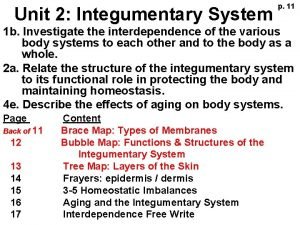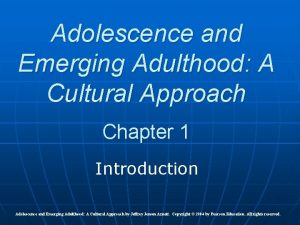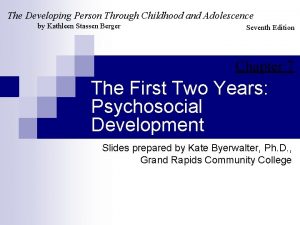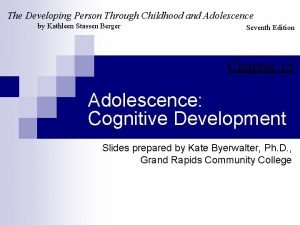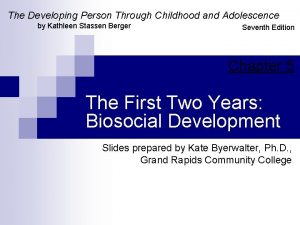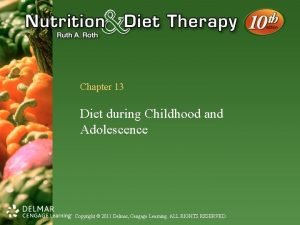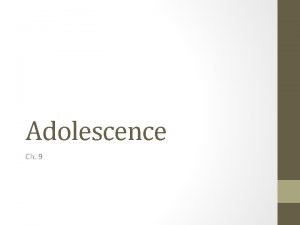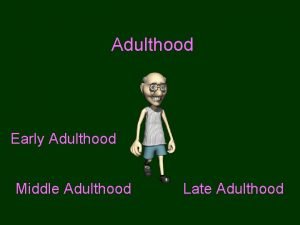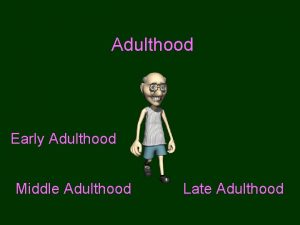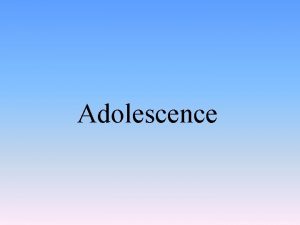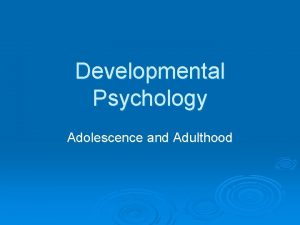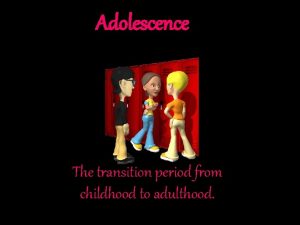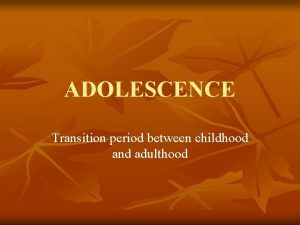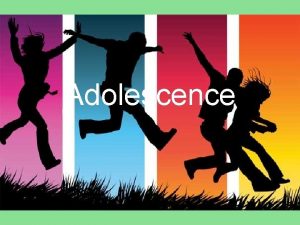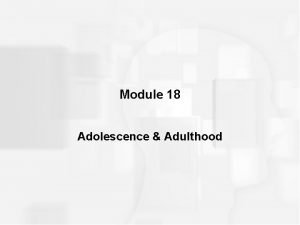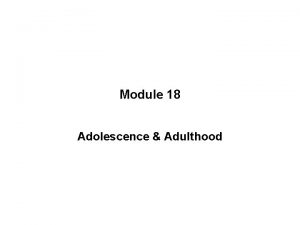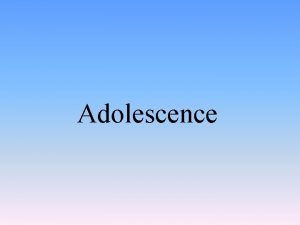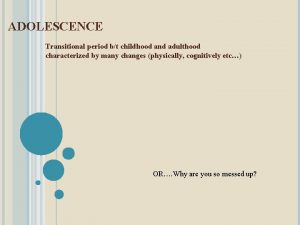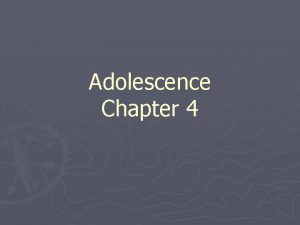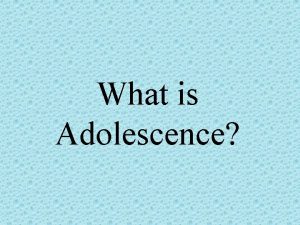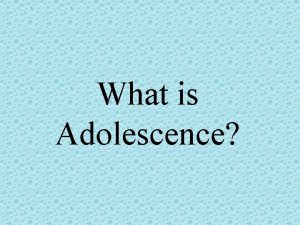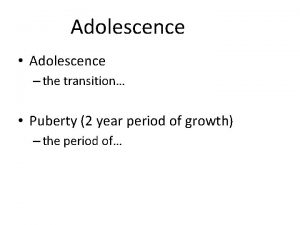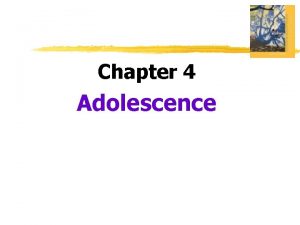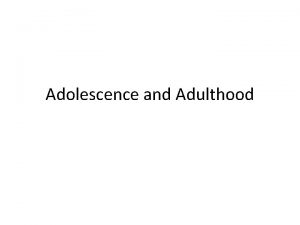Adolescence The transition period from childhood to adulthood






















- Slides: 22

Adolescence The transition period from childhood to adulthood.

Is adolescence getting longer or shorter?

Physical Development • It all begins with puberty Puberty: the period of sexual maturation, during which a person becomes capable of reproducing.

Primary Sexual Characteristics • The body structures that make sexual reproduction possible Ovaries Vagina Testicles Penis

Secondary Sexual Characteristics • Nonreproductive sexual characteristics Female breasts Hips Deepening of male voice Body hair

Puberty Sequence is way more predictable than the timing. How might timing differences effect an adolescent socially?

Lawrence Kohlberg and his stages of Morality • Preconventional Morality • Conventional Morality • Postconventional Morality

Preconventional Morality • Morality of self- interest • Their actions are either to avoid punishment or to gain rewards.

Conventional Morality is based upon obeying laws to 1. Maintain social order 2. To gain social approval

Postconventional Morality • Morality based on your OWN ethical principles. • You draw your OWN conclusions and make your own judgments

Social Development Its all about forming an identity!!!

Identity • One’s sense of self. • The idea that an adolescent’s job is to find oneself by testing various roles. • Comes from Erikson’s stages of Psychosocial development.

Identity • Some teenagers take their identity early by sharing their parents values and expectations. • Some teenagers will adopt a negative identity- opposition to society, but conforms to a peer group.

Intimacy • Towards the end of adolescence, intimacy becomes the prime goal. • Can you list the intimacy differences between men and women? • Next Slides are Erikson, chart handout is better

Trust vs. Mistrust Age Birth - 18 months Important Description Event Feeding Infants form a loving, trusting relationship with parents; they also learn to mistrust others.

Autonomy vs. Shame and Doubt Age 18 months - 3 Years Important Event Toilet Training Description Child's energies are directed toward physical skills: walking, grasping, and toilet training. The child learns control along with a healthy dose of shame and doubt.

Initiative vs. Guilt Age Important Description Event 3 - 6 Years Independence Child becomes more assertive, takes more initiative, becomes more forceful.

Competence vs. Inferiority Age 6 - 12 Years Important Description Event School The child must deal with demands to learn new skills while risking a sense of inferiority and failure

Identity vs. Role Confusion Age Important Description Event Adolescence Peers Teens must achieve self-identity while deciphering their roles in occupation, politics, and religion.

Intimacy vs. Isolation Age Important Description Event Young Adult Relationships The young adult must develop marriage-seeking relationships while combating feelings of isolation.

Generativity vs. Stagnation Age Important Description Event Middle Adult Parenting Assuming the role of parents signifies the need to continue the generations while avoiding the inevitable feeling of failure.

Integrity vs. Despair Age Late Adult Important Description Event Life Acceptance of Reflection one's lifetime accomplishments and sense of fulfillment.
 Infancy childhood adolescence adulthood old age
Infancy childhood adolescence adulthood old age Middle childhood and adolescence
Middle childhood and adolescence Adolescence and emerging adulthood a cultural approach
Adolescence and emerging adulthood a cultural approach The developing person through childhood and adolescence
The developing person through childhood and adolescence Adolescent egocentrism
Adolescent egocentrism Transient exuberance definition
Transient exuberance definition Developing person through childhood and adolescence answers
Developing person through childhood and adolescence answers Eating a balanced diet during childhood and adolescence
Eating a balanced diet during childhood and adolescence What is adolescence period
What is adolescence period Non metal halogen family 35 amu
Non metal halogen family 35 amu Trustee period and royal period
Trustee period and royal period The development of children 7th edition
The development of children 7th edition Classical period started from 1750 to 1872
Classical period started from 1750 to 1872 Critical vs sensitive period examples
Critical vs sensitive period examples Prehistory vs history
Prehistory vs history Absolute refractory period and relative refractory period
Absolute refractory period and relative refractory period Period of activism 1970 to 1972
Period of activism 1970 to 1972 When is the relative refractory period
When is the relative refractory period Stability period vs measurement period
Stability period vs measurement period Approaches to child development
Approaches to child development Critical period vs sensitive period
Critical period vs sensitive period Erikson's stage of adolescence
Erikson's stage of adolescence Deborah milbauer northeastern
Deborah milbauer northeastern
